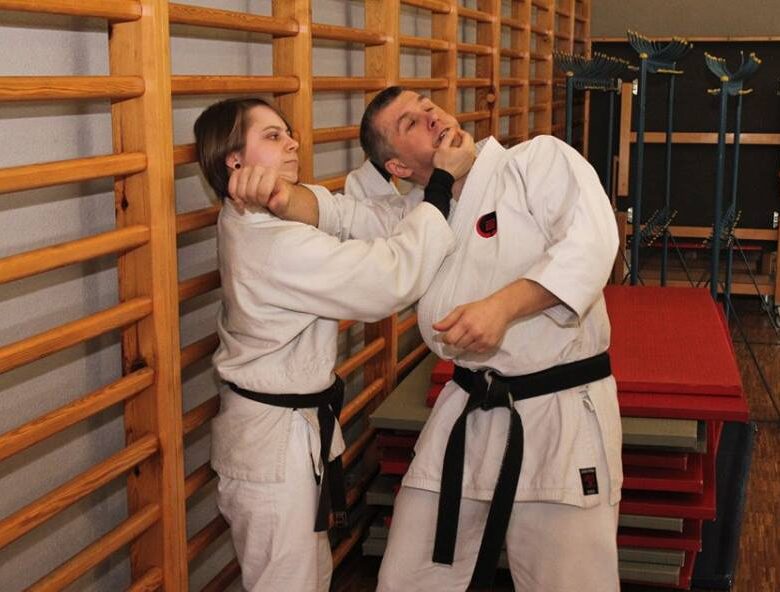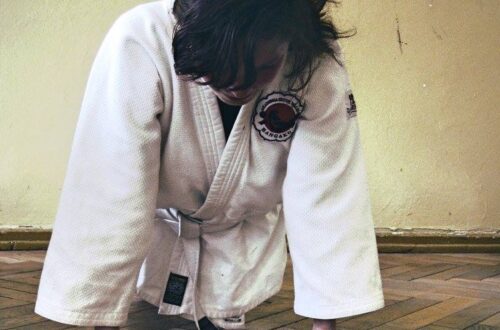
Dwie strony medalu czyli o uke i tori słów kilka|Two sides of the coin – a few words about uke and tori
Tori i uke. Dwa cudowne słowa, które poznajemy już na początkowym etapie treningu.
Jednak czy wiemy co dokładnie oznaczają?
Najbardziej popularne jest tłumaczenie, że tori i uke to partnerzy treningowi.
To oczywiście prawda, jednak i duże niedopowiedzenie.
Uke i tori są jak aktyna i miozyna w mięśniach. Muszą współdziałać, by były efekty. Gdyby ktoś pytał – aktyna i miozyna są to dwa wspaniałe białka tworzące sarkomer i umożliwiające skurcz mięśnia.
„Tori” to japońskie słowo oznaczające osobę, która wykonuje w danej chwili technikę. Pochodzi od czasownika toru – „wybrać”, „trzymać w dłoniach”.
„Uke” pochodzi od czasownika ukeru, dosłownie oznacza „otrzymać”, „przyjąć”. Terminem tym określa się osobę, na której przeprowadzamy technikę.
Jednak nie wszyscy wiedzą, że „tori” i „uke” to słowa płynne. Wg japońskiej terminologii nie określają jednoznacznie atakującego i broniącego się, ponieważ te role się zmieniają. Tori to ten, który ukończył technikę, a nie ją zainicjował.
Najczęściej to od osoby uke zależy jak będzie przebiegała praca nad techniką. Japońscy mistrzowie powiadają, że im lepszy uke, tym lepszy stanie się tori.
Dlaczego? Ponieważ uke jest osobą, która „przyjmuje” na siebie technikę swojego partnera. Pożycza swoje ciało by tori mógł ćwiczyć poprawność techniki. Im większe umiejętności posiada uke – chociażby lepiej pada na matę, ma wyższy próg bólu (bardzo pożądane w treningu dźwigni) tym bardziej realistycznie można ćwiczyć techniki.
Dobry uke jest także potrzebny instruktorowi/trenerowi/sensei. By ten mógł jak najlepiej zaprezentować uczniom technikę. Korzyść jest obopólna – bycie uke mistrza to zaszczyt ale przede wszystkim dobry sposób by się nauczyć. Robić szybciej postępy.
Trochę jak w szkole, szybciej się nauczysz jeśli nauczyciel weźmie Cię do tablicy (wyjątkiem byłam ja, gdy na matematyce miałam rozwiązać przy tablicy zadanie).
Często to jest ten moment przejrzenia na oczy. Ileż to razy moi koledzy z treningów zrozumieli sens rzutu dopiero gdy sami lądowali na macie? Nauka przez doświadczenie. Coś w tym jest.
Na koniec prosto z Japonii kilka wskazówek na temat bycia dobrym uke i tori.
Wykaż się entuzjazmem!
Zastanawiające, że to była pierwsza wskazówka na liście. Wygląda na to, że bardzo często partner jest raczej przestraszony, że ma wykonać ruch w stronę współćwiczącego, boi się zainicjować ruch, by nie zrobić krzywdy, lub też boi się przyjąć technikę bo nie chce czuć bólu.
Weź głęboki wdech i działaj, nie ma się czego bać jeśli tylko zaczniesz od małych kroków. Nikt na pierwszym treningu nie jest rzucany na tomoe nage!
Zostaw swoje ego za drzwiami!
Znaczy to ni mniej ni więcej tylko szacunek dla partnera. Masz ułatwić swojemu partnerowi uczenie się a nie pokazywać że jesteś lepszy. Nie lekceważ swojego partnera. Dobrze mieć dumę w sobie, ale pamiętaj – uczymy się całe życie. Nawet gdy trenujesz z białym paskiem to możesz się od niego czegoś nauczyć.
Jeśli masz wiedzę i umiejętności pozwalające by poprawić partnera to zrób to. Ale z szacunkiem a nie wyższością.
Daj swojemu partnerowi poczuć dobrą technikę!
Nie bądź bezwładny, obojętny ani nie stawiaj niepotrzebnego oporu. Każdy atak i obrona powinny być wykonane z pełnym przekonaniem, zaangażowaniem, Ale pamiętaj, by dostosować siłę i szybkość do swojego partnera. Tak, by był w stanie sobie poradzić.
Pamiętaj, że oboje się uczycie.
Tori – jak prawidłowo przeprowadzić skuteczną technikę, uke – jak ją przyjąć. To jest partnerstwo.
Trenuj bezpiecznie!
Nie szkodzimy sobie nawzajem. Nie chodzi o to by wybić partnerowi zęby, skopać go czy rzucić z taką siłą by podskoczyła pod nim mata. Słuchaj swojego partnera, reaguj na jego słowa i sygnały. Jeśli odklepał to zwolnij dźwignię czy duszenie. Gdy słyszysz, że jego kolano robi głośne POP, to zwróć na to uwagę, a nie zignoruj z pogardliwym spojrzeniem.
Myślę, że przede wszystkim każdy z tych punktów łączy szacunek. Nie da się schrzanić bycia dobrym tori/uke jeśli mamy szacunek do siebie i innych. Warto o tym pamiętać.
_________________________________
Tori and uke. Two wonderful words that we learn at the initial stage of training.
However, do we know what exactly they mean?
The most popular translation is that tori and uke are training partners.
This is of course true, but also a big understatement.
Uke and tori are like actin and myosin in the muscles. They have to work together to get results. If anyone asked – actin and myosin are two wonderful proteins that make up the sarcomere and enable muscle contraction.
„Tori” is the Japanese word for the person who is performing the technique at the moment. It comes from the verb toru – „choose”, „hold in your hands.”
„Uke” comes from the verb ukeru, literally means „to receive”, „to receive”. This term is used to describe the person on whom the technique is performed.
However, not everyone knows that „tori” and „uke” are fluid words. According to Japanese terminology, they do not clearly define the attacker and the defender, because these roles change. Tori is the one who completed the technique, not initiated it.
Most often it is up to the uke person how the work on the technique will go. Japanese masters say that the better the uke, the better the tori will become.
Why? Because uke is a person who „adopts” his partner’s technique. He borrows his body for tori to practice correct technique. The more skills the uke has – even if it falls on the mat better, has a higher pain threshold (very desirable in joint locks training), the more realistically you can practice techniques.
Good uke is also needed by the instructor / trainer / sensei. So that he could present the technique to the students in the best possible way. The benefit is mutual – being a uke master is an honor but above all a good way to learn. Make faster progress.
A bit like at school, you will learn faster if the teacher takes you to the blackboard (the exception was me, when I was supposed to solve a problem at the blackboard in maths).
Often this is the moment when you see your eyes. How many times did my colleagues from training understand the meaning of the throw only when they landed on the mat themselves? Learning through experience. There is something about it.
Finally, straight from Japan, some tips on being a good uke and tori.
Be enthusiastic!
Puzzling, that was the first clue on the list. It seems that very often the partner is rather scared that he is to make a move towards the exercising person, he is afraid to initiate a movement so as not to hurt, or he is afraid to adopt the technique because he does not want to feel pain.
Take a deep breath and act, there’s nothing to be afraid of as long as you start with small steps. Nobody is thrown at tomoe nage in the first training session!
Leave your ego at the door!
It means no less and no more than respect for your partner. You are to make it easier for your partner to learn, not to show that you are better. Don’t underestimate your partner. It’s good to have pride in yourself, but remember – we learn all our lives. Even when you train with the white stripe, you can learn something from it.
If you have the knowledge and skills to improve your partner then do it. But with respect, not superiority.
Give your partner a feel for a good technique!
Don’t be inert, indifferent, or put up unnecessary resistance. Each attack and defense should be done with full conviction, commitment, But remember to adjust strength and speed to your partner. So that he would be able to cope.
Remember that you are both learning.
Tori – how to properly perform an effective technique, uke – how to adopt it. This is a partnership.
Train safely!
We do not harm each other. It’s not about knocking out your partner’s teeth, kicking him or throwing him with enough force to make the mat jump under him. Listen to your partner, react to his words and signals. If he tapped it off, release the joint lock or choke. When you hear his knee making a loud pop then pay attention to it and don’t ignore it with a contemptuous look.
I think that above all, each of these points is united by respect. It is impossible to screw up being a good tori / uke if we have respect for ourselves and others. It is worth remembering this.





